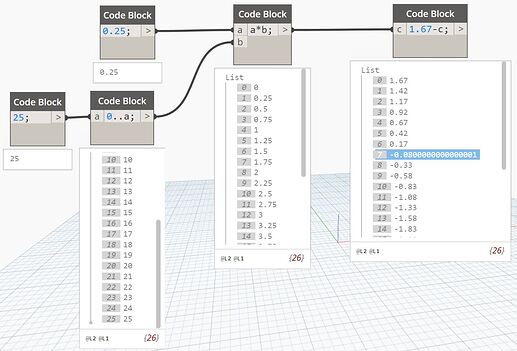Hi all,
I got a question. why does dynamo sometime calculate wrong. look at this example
in thw last code block on index [7] the calculated number is wrong.
how can i prevent dynamo in this. because later on in one of my processes i have to use list.containsitem with a different list which has the correct number of -0.08 in it but the answer wil be false due to the wrong number.
hope someone can explain/solve this for me?
this is my file:Why these digits 0_01.dyn (3.2 KB)
Using simple dynamo studio (Core1.3.4.6666/studio 1.3.0.946)
Wouldn’t Rounding the Digits Solve the Problem?
1 Like
SeanP
June 7, 2021, 1:33pm
3
I haven’t seen just plain wrong values like that before. Maybe it’s the older version your using?
https://dynamobuilds.com/
Edit:
1 Like
I don’t think it’s wrong. It has to do with the way that double-precision floating point numbers work. This isn’t unique to Dynamo.
https://www.exploringbinary.com/why-0-point-1-does-not-exist-in-floating-point/
So basically, if you need precision out to the 16th decimal place, don’t use a double. Or just round it off
5 Likes
paris
June 7, 2021, 1:59pm
5
Hi @1234eddie like @ashwinash112 said maybe try use Round function
cheers
2 Likes
What’s the source of those numbers? Revit measurements?
I don’t think it’s wrong. It has to do with the way that double-precision floating point numbers work. This isn’t unique to Dynamo.https://www.exploringbinary.com/why-0-point-1-does-not-exist-in-floating-point/
@zachri.jensen is correct - this isn’t a Dynamo thing, but rather a dot net thing - C# Online Compiler | .NET Fiddle with double precision numbers
I suggest you round the numbers like others have mentioned in this thread!
6 Likes
Thanks everybody.
for now i solved it for myself by using ‘object to string’ followed by ‘string to number’.
1 Like

